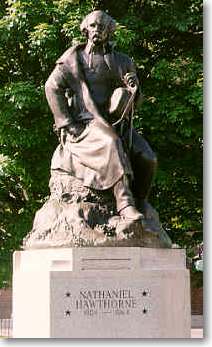by Nathaniel Hawthorne

| "Dr. Heidegger's
Experiment" by Nathaniel Hawthorne |
 |
"Dr. Heidegger's Experiment" is another one of Nathaniel Hawthorne's famous short stories. It is a classic tale of an old man who learns a lesson by watching his friends. Do we learn from our past? Or are we doomed to the same mistakes?
This story is described as an allegory. An allegory is a tale in which characters or objects stand for certain abstract qualities, such as Hope, Faith, Shame, Vice. This is more directly seen in "Young Goodman Brown" where the characters are directly named "Good-man" and his wife "Faith." The most famous allegory in English is Bunyan's The Pilgrim's Progress (1687). Here a man named Christian journeys to the Celestial City, meeting along the way characters named Hope, Worldly Wiseman, Despair, and others who are personifications of human qualities. In allegories, the complexities of human character are usually less important than the abstract qualities that they represent.
In "Dr. Heidegger's Experiment," the characters do not have allegorical names. For instance, Mr. Medbourne is not called "Greed." Yet his whole character seems to be summed up in the sentence that introduces him. "Mr. Medbourne, in the viogr of his age, had been a prosperous merchant, but had lost his all by a frantic speculation and was now little better than a mendicant." When he is restored to youth, he immediately resumes these old pursuits, becoming "involved in a calculation of dollars and cents." It appears that greed is the whole of his character. Each of the characters represents a particular aspect of human nature to the exclusion of other aspects.
Allegory is related to symbolism. Whereas an allegory stresses the abstract meaning, a symbol contains an actual and an abstract meaning. A common example of a symbol is a flag. It is literally a piece of cloth, but as the flag of a country, it is also associated with political and historical events, loyalty, patriotism, and many other public and private feelings. Every culture has its symbols. Literature draws upon these symbols but also creates others. Henry David Thoreau, for instance, made the act of building his house at Walden Pond a symbol of structuring his life, and he found in the seasons of the year a symbol for the stages of human existence.
Hawthorne's story uses certain objects as symbols. For example, a mirror is, in literal terms, an object in which we can see our own reflection. But, as Dr. Heidegger also sees in his own mirror the images of his deceased patients, the mirror symbolizes his past failures, those patients he could not save. This symbol is a key to the character of Heidegger, who is so aware of human limitations that he would not be young again even if he could be.
On this web site you will find the complete text of the story as well as other web pages that will help you in your understanding of this great short story.
["Dr. Heidegger's Experiment -- Complete Text]
[Summary & Comments] [Quiz]